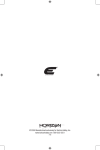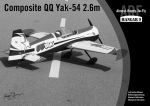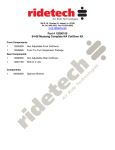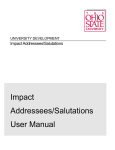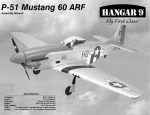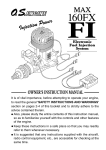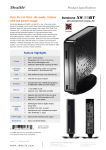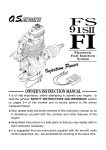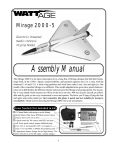Download Horizon quarterly - Aero Accessories
Transcript
P-47 THUNDERBIRD 150 ARF Getting Ready for Combat Converting the Hangar 9 Thunderbolt 150 ARF for Competition By Dino Di Giorgio, Team JR 325th Fighter Group Markings– Hangar 9’s P-47D Thunderbolt “Razorback” 150 ARF is based bombs, display propeller, functioning flaps that improve landing on a full-size warbird flown in World War II combat by Captain 317th Fighter Squadron, 15th Air Force. Scale detailing is spot performance, and heavy-duty UltraTract™ metal retracts that are Notes by Colonel Robert Baseler of the 325th Fighter group. designed for easy setup, scale looks and trouble-free operation, I thought the distinctive identification of the 325th Fighter flight after flight. on, right down to the iconic #11 on the “jug,” the combat- This article will explain in detail how you can take ready “Razorback” fuselage and a period-authentic UltraCote® the Hangar 9® P-47D 150 and convert it for entry in scheme. Other realistic scale details include the molded air competition scale events. Herschel “Herky” Green, the charismatic commander of the scoops and vents, greenhouse canopy, wing fillets, belly tank, Group would look good on the tail section, so I started adapting the color scheme. John Watkins worked with me. Our first attempts included black and white checks and red and white checks, which, at a distance, looked all red. We finally tried Stripping The P-47D ARF comes out of the box factory-covered in authentic UltraCote. I took a deep breath while holding the Xacto knife and, for a moment, I felt like a surgeon. I knew it would be just fine after the first cut. You must remove the original covering before you can re-cover it in your own scheme. Lightly lift the areas where the covering overlaps. Once the covering is loose, most of the removal is quite easy. It becomes a little harder when you come to some areas where Hangar 9 has painted some plastic to match the covering. Take a heat gun and warm up the covering. After the covering is warm enough, it will start to curl. Then, it’s ready to be removed. There will be some residue of glue and paint. This will be removed shortly. Continue until you have all the covering removed from the airplane. Upgrades Prep Work It was time to make some decisions on what would be added to the airframe before sanding began. I contacted Bill Stevick from Bob Dively Models (www. bobdivelymodels.com) to see if he had a cockpit that would fit our Jug. We required an all-new cockpit. Bill went to work and, within a few days, completed a prototype. The only necessary modification would require you to cut a former out of the hatch and fuse below, which is very simple. The cockpit is built around a balsa frame. After it is cut, assembled and painted, it’s ready to fit the balsa walls (which are required but not included in the cockpit kit). Now, start preparing the plane for fiberglass cloth. Take 220-grit sandpaper and lightly sand over the entire airframe. You might notice some areas that require some wood filler. Open a can of Micro-Fill (NHP 201) or a similar product. The more you fill now, the less you have to fill after the primer is sprayed on. I recommend lightly wet-sanding the cowl with 400-grit paper to smooth it out. It doesn’t need to be stripped down to the glass. I found that a little extra nose weight was needed anyway. After you have filled and sanded those areas, final-sand with dry 320-grit paper. When this step is complete, take a compressor and blow off the remaining dust. If you don’t have a compressor, you might be able to reverse your vacuum. Pick up any remaining loose dust with a tack cloth. You need to buy enough glass to cover the entire plane, including the control surfaces. Most fiberglass comes in 38” width, depending on your source, and you’ll need 25 feet of cloth. This particular lightweight cloth came from Aero Accessories (www.aero-accessories. com) in a 38” width. You’ll also need some inexpensive 2- to 3-inch throwaway brushes, epoxy finishing resin, some mixing cups and 91% isopropyl alcohol. My method of laying the resin on the plane may vary depending on your resources. First, I cut the cloth to match the outline of the part. Take one small 1-ounce mixing cup to mix Z-Poxy’s Finishing Resin (PAAPT40) two-part epoxy in. Make sure you carefully pour ¼ ounce of resin in the cup, followed by ¼ ounce of hardener. Mix those two parts very thoroughly. Add the other ½ ounce of 91% alcohol to the cup, and mix that up until you get a light brown color and all the mixing swirls blended in. Pour that into a plastic container. Take your brush and apply the resin to the cloth. You don’t need to make it heavy, since two coats are needed. You will not need a rubber card or squeegee for this method. After the coat is complete, let it dry. Move on to all the remaining parts until all parts are complete, and they have dried overnight. Then, apply a second coat of resin on all the parts. Priming for Paint After the parts have dried, take a piece of 220-grit and sand away the loose pieces of cloth. Sand the entire plane with 220 to get rid of any lumps that have settled during the drying phase. I chose Pactra-Prep primer to prime the entire Jug. Spray the parts one at a time using light coats. Allow drying between coats, or you may have problems lifting the colors at the end. Sand the parts using 220 until smooth. You want to fill any holes you may have missed from the second coat of resin. After you have put on a few coats, check to see where you might need some lightweight “red” body putty to fill any small dents or holes that you were not able to fill with the primer. Let the putty dry and sand smooth. You are ready to lay a light coat of primer back on. I then took a 3-view drawing and laid out the panel lines with some 1/16-chart tape. You may use various sizes, according to your liking. The method I use to build up the panels is simple. Spray 4–5 light coats over the panel lines only and let dry. Sand the surfaces with 320 paper lightly, especially around the tape. Remove all the chart tape. I chose to make the exhaust and vent area more detailed. Take some lightweight aluminum and bend some vents to shape. Cut a slot for them to slide into. Then take a piece of brass tubing cut on an angle and glue in with some thick CA or silicone from the inside. Touch up the parts with a shot of primer. Take the tack cloth and remove all the dust that’s left over. Next, take some Krylon dull aluminum spray paint and spray the entire Jug. The panel lines should be slightly noticeable now. Since we are adding some details, I thought it would be perfect to add some raised access panels. You can easily achieve this by using Aero Foil, which is a high-grade lightweight self-adhesive product exclusively sold through Aero-Accessories. Cut out the panels with a sharp knife or by using scissors. Peel the back liner off and stick on. You can use a spoon or the corner of a brush to burnish the panel on. You will need to cover the entire tail where the Checkertail markings will go with white primer. You’re using white, because the yellow paint will not cover well over any other paint. It is extremely important that you mask off the tail before painting the white primer. Checkertail I used Bob Dively’s Liquid Masking Film (LMF), which you can buy from most hobby shops or directly from Bob Dively Models. The first step is to paint multiple coats of yellow over the white primer and allow the paint to dry completely. At this time, apply the first layer of LMF using a disposable foam brush. Allow the LMF to dry at least one half-hour or until the film is almost clear. Apply two more coats allowing each coat to dry. Let the LMF dry overnight before laying out the Checkertail lines. We estimated the size of the squares based off documentation drawings. The approximate size came to 17∕8 inches. Layout the squares using a square and starting 90 degrees from the leading edge. Mark the LMF surface with a ballpoint pen. Measure back from the leading edge another 17∕8 inches until you complete the surface. This method is used for both vertical and horizontal surfaces. Take a sharp Xacto knife and score along the lines carefully. You do not need to cut into the surface. Mark each black square, so you know what square will be removed for painting. Make sure that the alternate black and yellow squares cover the entire surface including the round edges. Now remove the squares marked “X” for black paint. Once all squares are removed, you may paint them using matte black paint. When the black has set, carefully peel the remaining LMF from the surface. Now you have completed the art of the Checkertail. Once again, you will have to mask the entire tail from overspray when painting the fuse and make sure that you leave the tail to dry for a few days. Painting 3 ways to BUY 877-504-0233 hobby store locator horizonhobby.com 800-338-4639 to order by phone t Fiberglassing | Summer 2006 degrees to the leading edges of the vertical and horizontal tail surfaces. You could see that Checkerboard tail almost as far away as you could see the entire aircraft. Since we chose to paint the P-47D in the same color and markings as the ARF covered version, I chose to use Tamiya spray paint and Testors acrylic. Take some tack cloth and wipe down the aluminum for any overspray. I generally paint the bottom first. This way, the green will cover more easily over the gray. Using Tamiya’s AS-7, spray both wings and the lower part of the fuse with several light coats. You will use 3–4 cans for this process. After the parts dry, paint the Olive Drab using approximately 3–4 cans of Tamiya AS-6 paint. You can paint the fuse without the cowl or canopy at this time. The canopy is prepped just like the tail. Using LMF, lay four coats over the outside of the canopy, while drying between coats. When finished, take the Xacto and lightly scribe lines around the raised window frames. Make sure you leave the LMF attached to the window. Carefully lift the LMF off the frame, because that’s where the paint will go. Watch your corners where you cut. Sometimes it’s easy not to make contact with the other corner, and then it will start to lift. If this occurs, push it back down with a finger and cut the lifting part with the knife. Once the LMF has been removed from the frame, you may paint the canopy, but make sure only the film is left on the windows. I recommend that you place some paper or tape on the inside to avoid overspray. After priming and sanding the cowl, mask off where you need to paint the white primer on the nose. There is a small yellow and white band that needs to be masked using flexible 3M blue line tape or similar. I painted using Tamiya TS-34 Camel Yellow, TS-27 Matte White and TS-49 Bright Red. Mask off the nose when dry. Paint the gray and then the rest of the OD green to match the fuse pattern. ZENOAH ENGINES Markings Hangar 9 did all the work for you on the nose art. I felt no need to change it. Align the Varga “blonde,” and stick it where you think looks best. When it came to finding paint masks, I went to industry-leader Jerry Caudle from Pro-Mark Graphics (www.promark.com). Jerry sent perfect masks for the Stars and Bars, as well as the #11 for the fuse and under the cowl. Trim the excess vinyl around the template and leave about 1 inch of border. If the mask does not fit around the curve, simply pull a little (the material stretches). Using TS-27 Matte White, spray the entire mask as a base coat. You may have numerous layers of paint to coat over the green. Once the white has dried, align the top mask and spray Testors Enamel Insignia Blue in light coats. You will have to get out a small air gun for the blue; it’s not available in a spray that I am aware of. Paint the edges down first. You only need to paint over the exposed areas. I chose Testors Enamel Insignia Blue over the acrylic simply because it looked like a better shade. You can now lay out the #11 on the fuse and bottom of the cowl the same way. After you paint the small #11 on the cowl, shoot a light coat of yellow for the final. Detailing Good job! You’re almost done. Now, take some 320-grit wet sandpaper and lightly sand down the green until some areas of the silver show through. Especially, sand down the panel lines again very lightly. Don’t go further than the silver paint. And remember to keep the sandpaper wet. Once you are happy with the result, lightly wet-sand with 400-grit. Make the leading edges of the wing and tail a little more damagedlooking than the rest. Wipe down the plane with water and paper towels to remove the sanded paint. If you would like to add rivets, you may do so using a soldering gun with a piece of sharpened brass tubing. Keep the heat very low; it’s easy to puncture the skin if it’s too hot. All you’re trying to do is score the paint. Add the canopy to get ready for the last stage of painting. Clear Coat Now that the plane is in its final stages, we can proceed to the clear-coat process. Wipe down the plane with water and towels and go over it with the tack cloth. For clear, I chose a product called Base Fix from Sikkens automotive. You can find this in most auto body shops. It’s a one-part spray that doesn’t need to be reduced, so it’s easy to use and apply. When you are spraying the plane, I recommend two light coats. The heavier you lay it down, the glossier the shine. Since this is a warbird, we don’t want it shiny. Remember to take the LMF off the canopy with an Xacto knife. Weathering I like to add some more dirt to the plane, so I used pastel chalk from the local art supply store. You can purchase a combo kit that has some black, gray and brown colors. Sand the chalk into powder with 120-grit paper. This will be a messy job because of the fine powder, so be sure you are in an open area. Dip a disposable brush into the powder. Lightly streak the brush across the exhaust area and/ or gun ports. You can use the chalk wherever you see it might add some realism. Using various pastels, you can highlight the exhaust too. Even though you place the chalk over the clear, it will stay attached to the surface for a long time. Engine, Radio & Accessories www.aero-accessories.com The Evolution 35GT gas engine (EVOE35GT) is perfect for the Jug. It fits into the cowl using the engine mounts included with the ARF kit. The ignition mounts in the firewall box with a strap. Cut the ignition monitor light lead, solder a connector in between, and mount the light in the gunsight inside the cockpit. The Jug comes with a very nice centerline static tank. The hard mount is already inside the belly. I looked at it and thought I could make the tank removable without much work. I used a small drop tank release system from Aero Accessories. All you have to do is cut a slot in the fuse for the release switch and add a 2/56 wire with a clevis. Attach a sub-micro servo such as the JR S241 or JR SPORT SM15. Mount the servo in the fuse and you are set. Adding a TruTurn Prop Hub (www.tru-turn.com) simply made the P-47D come to life. You can’t fly without one! About the Author Dino Di Giorgio has been flying model aircraft since before his eighth birthday. As a teenager, he discovered the excitement of giant-scale competition and began collecting warbirds. Dino has been a member of Team JR for twelve years and, in 1992, began competing at Top Gun, where he has earned three Team Scale 1st-place trophies. You can easily see Dino flying, competing and having a good time at warbird, scale and jet RC events year round. P-47D Thunderbolt 150 ARF Realistic scale details include a combat-ready "Razorback" fuselage, molded air scoops and vents, greenhouse canopy, molded fiberglass wing fillets, belly tank, bombs, display propeller and more. Wingspan 81.25 in • Wing Area 1164 sq in Length 71 in • Weight 15–17 lb Radio 5 channels w/6 servos Engine 1.20–2.10 2-stroke; 1.20–2.10 4-stroke; 26–35 cc gas Motor (electric conversion); E-flite Power 110 (EFLM40110A) P-47 Thunderbolt 150 ARF w/Retracts HAN2700 List Price 799.99 569.99 2 ricx/ P-40E Warhawk 60 ARF w/Retracts HAN2850 List Price 329.99 259.99 1 Wingspan: 65.5 in P-51D Mustang 60 ARF w/Retracts HAN2375 List Price 329.99 254.99 1 Wingspan: 65.5 in P-51D Miss America 60 ARF w/Retracts HAN2775 List Price 319.99 254.99 1 F6F Hellcat 60 ARF The F6F Hellcat was one of World War II’s deadliest fighters. Hangar 9’s .60-size replica looks like the real thing, right down to the painted fiberglass cowling, accurate period decals and factory-installed mechanical retracts that rotate 90 degrees. The servos even mount inside the airplane to maintain the incredible scale looks. And as if its cool appearance wasn’t enough, the Hellcat 60 ARF also performs like a classic sport airplane, eagerly handling huge loops, smooth rolls and other light aerobatics. Wingspan 64.6 in • Wing Area 709.4 sq in Length 52 in • Weight 8.25–9.5 lb Radio 5 channels w/6 servos Engine .60–.78 2-stroke; .91–1.00 4-stroke Power 110 ric/ F6F Hellcat 60 ARF w/Retracts HAN4075 339.99 264.99 3 ways to BUY 877-504-0233 hobby store locator horizonhobby.com 800-338-4639 to order by phone Wingspan: 64.6 in Wingspan: 67.5 in AT-6 Texan 60 ARF w/Retracts HAN1925 List Price 319.99 254.99 1 Piper J-3 Cub 40 PNP & ARF Marvel at the scale realism of Hangar 9’s J-3 Cub PNP. Factory-painted scale wing struts are constructed from airfoil-shaped aluminum. Factory-assembled scale landing gear feature simulated bungies and smooth shock absorption that stand up to everyday flying. Or, if you prefer using your own engine and servos, the Piper J-3 Cub 40 is also available as an ARF that offers the same scale realism. Wingspan 80 in • Wing Area: 932 sq in Length 51 in • Weight 7–7.5 lb Radio 4 channels w/5 servos (servos installed on PNP) Engine (PNP) Evolution .46NT (installed) Engine (ARF) .46–.50 2-stroke; .56–.82 4-stroke eic, PNP eic. ARF Piper J-3 Cub 40 PNP HAN4025 List Price 599.99 409.99 2 Piper J-3 Cub 40 ARF HAN4000 List Price 319.99 209.99 2 Wingspan: 65.25 in F4U Corsair 60 ARF w/Retracts HAN2575 List Price 339.99 264.99 2 | Summer 2006 SCALE And For Sport FoR For a faithful wartime flying experience, try Hangar 9’s comprehensive series of classic warbirds. Not only are they marked by their realistic scale detail, but each airplane can also offer show-stopping sport performance for an exhilarating weekend at the flying field. Plus, they all live up to Hangar 9’s high standards, including up-to-date construction techniques, period-authentic UltraCote® trim schemes and lightweight all-wood parts. And if you’re into electric flight, most Hangar 9® warbirds can be adapted to electric power optons. Wingspan: 65.in P-47 Thunderbolt 60 ARF w/Retracts HAN2975 List price 329.99 259.99 2




